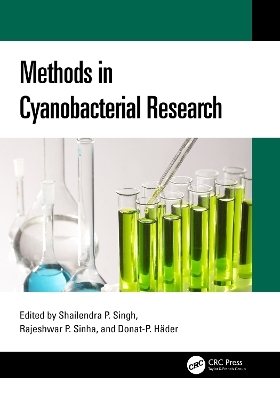
Methods in Cyanobacterial Research
CRC Press (Verlag)
978-1-032-49834-8 (ISBN)
Key Features:
Provides step-by-step procedures and troubleshooting tips
Covers identification, growth parameters and pigment estimation methodologies
Describes isolation, characterization and purification of microcystin, phycobiliproteins and scytonemin from cyanobacteria
Discusses genomics, proteomics and bioengineering of cyanobacteria from novel products
Explains sample preparation and visualization protocol for electron microscopy-based analysis of cyanobacteria
This collection is useful to students and researchers in life sciences. It is also meant for industry experts who are involved in the production of biofuels, biofertilizers, other value-added products, and carbon sequestration using cyanobacteria.
Dr. Shailendra P. Singh is an Assistant Professor at the Centre of Advanced Study in Botany, Institute of Science, Banaras Hindu University (BHU), Varanasi, India. He earned his PhD from the Department of Biology, Friedrich-Alexander University, Erlangen-Nuremberg, Germany. Prof. Dr. Rajeshwar P. Sinha, DAAD Fellowship Awardee and Fellow, Society for Applied Biotechnology, India, is a Professor of Molecular Biology, Centre of Advanced Study in Botany, Institute of Science, Banaras Hindu University (BHU), Varanasi, India. Prof. Donat-P. Häder is the past-Director of the Botanical Institute and held the chair of Ecophysiology of Plants at the Friedrich-Alexander University, Erlangen-Nürnberg, Germany. He was also the director of the Botanical Garden.
Chapter 1: Evaluating the polyphasic approach in cyanobacterial taxonomy
Chapter 2: Estimation of growth and photosynthetic pigments in cyanobacteria
Chapter 3: Quantitative estimation of total carbohydrate, protein and lipid contents in cyanobacteria
Chapter 4: Isolation and purification of phycobiliproteins
Chapter 5: Methods for estimation of oxidative stress indices in cyanobacteria
Chapter 6: Estimation of glutamine synthetase enzyme
Chapter 7: Estimation of nitrate reductase enzyme
Chapter 8: Estimation of nitrogenase enzyme activity in cyanobacteria
Chapter 9: Isolation and purification of cyanobacterial toxins
Chapter 10: Isolation and purification of scytonemin
Chapter 11: Isolation and purification of mycosporine-like amino acids
Chapter 12: Protein estimation in cyanobacterial samples
Chapter 13: Proteomic analysis of cyanobacteria employing 2-dimensional gel electrophoresis (2-DE)
Chapter 14: LC-MS/MS based proteomics study of cyanobacteria
Chapter 15: Monitoring photosynthetic performance in cyanobacteria by a modulated fluorometer
Chapter 16: Reactive oxygen species measurement in cyanobacteria using 2′,7′- dichlorodihydrofluorescein diacetate (DCFH-DA) dye and fluorescence microscope or flow cytometer
Chapter 17: Flow cytometry-based methods for estimating DNA content and live-dead cells in cyanobacteria
Chapter 18: Genomic DNA and RNA extraction from cyanobacteria
Chapter 19: Detection and quantification of DNA damage in cyanobacteria by immunodot- blot assay
Chapter 20: Engineering cyanobacteria for the synthesis of novel products
Chapter 21: Sample preparation and visualization protocol for electron microscopy-based analysis of cyanobacteria
Chapter 22: Cyanobacterial biofertilizer production technology
Chapter 23: Biomass composition measurement and intracellular flux analyses for insights into cyanobacterial metabolism
Chapter 24: In silico genome assembly and functional annotation
Index
| Erscheinungsdatum | 13.06.2024 |
|---|---|
| Zusatzinfo | 12 Tables, black and white; 42 Line drawings, color; 31 Line drawings, black and white; 8 Halftones, color; 4 Halftones, black and white; 50 Illustrations, color; 35 Illustrations, black and white |
| Verlagsort | London |
| Sprache | englisch |
| Maße | 178 x 254 mm |
| Gewicht | 625 g |
| Themenwelt | Naturwissenschaften ► Biologie ► Botanik |
| Naturwissenschaften ► Geowissenschaften ► Geologie | |
| Technik ► Elektrotechnik / Energietechnik | |
| Weitere Fachgebiete ► Land- / Forstwirtschaft / Fischerei | |
| ISBN-10 | 1-032-49834-X / 103249834X |
| ISBN-13 | 978-1-032-49834-8 / 9781032498348 |
| Zustand | Neuware |
| Informationen gemäß Produktsicherheitsverordnung (GPSR) | |
| Haben Sie eine Frage zum Produkt? |
aus dem Bereich


